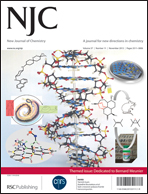Supramolecular assemblages between three different [Zr(A)4]4− metallotectons (A stands for oxalate, Ox2−; dihydrobenzoquinonate, DBQ2−; or chloranilate CA2−) and three different guanidinium cation analogues (guanidinium, H-Guan+; 2-amino-imidazolium, H-AIm+; and N,N-dimethylguanidinium, H-DmG+) have been envisioned to investigate how the anionic and/or cationic building-block characteristics influence the connectivity and/or the dimensionality of frameworks based on charge-assisted H-bonds. Added to the benchmark material, {(H-Guan)4[Zr(Ox)4]}, (1), the crystal structures of six architectures of formula {(H-AIm)4[Zr(Ox)4]}·5H2O (2), {(H-DmG)4[Zr(Ox)4]}·0.5H2O (3), {(H-Guan)4[Zr(DBQ)4]}·1.5H2O (4), {(H-Guan)4[Zr(CA)4]}·5.85H2O (5), {(H-AIm)4[Zr(CA)4]}·H2O (6), and {K2(H2O)3(H-DmG)2[Zr(DBQ)4]}·H2O (7) have been characterized. While 1 consists of a two dimensional (2D) H-bonded network with compact structure, four out of the six supramolecular architectures (2–7) form 3D H-bonded networks, and three of these materials (namely, 2, 4 and 5) present open-framework architectures with solvent accessible voids ranging from 8 to 13%. Compounds 4–7 are the first examples of H-bonded frameworks constructed from [Zr(DBQ)4]4− and [Zr(CA)4]4− metallotectons.
![Graphical abstract: Extended H-bond networks based on guanidinium H-donors and [Zr(A)4]4− H-acceptor units: modulation of the assemblage and guest accessible volume by chemical design (A = oxalate, dihydrobenzoquinonate, chloranilate)](/en/Image/Get?imageInfo.ImageType=GA&imageInfo.ImageIdentifier.ManuscriptID=C3NJ00520H&imageInfo.ImageIdentifier.Year=2013)

 Please wait while we load your content...
Please wait while we load your content...